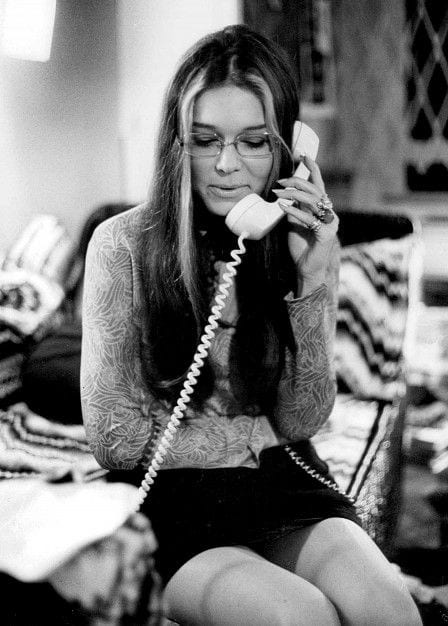The 1960s were simply a whirlwind of events, there were social and political changes left and right. The ever-changing society was filled with chatter of the first man in space, and woman changing the rules. Among them, Gloria Steinem, an independent role model for young girls through the sixties and even now. Gloria Steinem was responsible for making worldwide advancements by pushing the boundaries of journalism and exposing women’s rights. She challenged a system that has not supported minority groups for so long. Making this social change, among many others (environmental, civil rights, labour laws) has affected the political world, bringing the world to the brink.

What’s the deal with the collage?
The picture above was created by me using different forms of media. The apps I used to create this were eraser and pages. The idea behind this was to bring in both the political and social side of the 60s in a creative way. The background is actually a drawing from a Soviet space cartoon. I also added the Soviet cosmonaut in the corner which I found in a Soviet propaganda poster. The background is an obvious representation of the political space race! The poster was also put together by me, it includes many influential people and events in the 60s (Martin Luther’s King, JFK, Vietnamese war, rallies etc…). Finally, front and center is a famous Image of Gloria Steinem speaking at the 1972 Miami Democratic National Convention. The photo as a whole is what truly brought the world to the brink in the 60s.
As a woman in the 60s (and centuries before) your life was planned out like a blueprint for a building. You were sketched into society, pushed through doors and cornered into a life you don’t belong in. As you enter the world as a young woman you were told to marry, buy a house, have kids, cook and clean. You could not have a credit card, serve on a jury, go on birth control, go to an ivy league school or experience equality in the workplace.

People (especially woman) were getting inspired, there were movements happening left and rights. The civil rights movement was sparking people to challenge the system where equality was due. Gloria Steinem was a perfect example of somebody challenging a system, therefore pushing it to the brink. Her natural writing ability, leadership, strength and attitude allowed her to defy the standards for woman in her age. As a journalist gloria Steinem had many successful articles, one of her more famous ones being “A Bunny’s Tale”. This article was groundbreaking, it discussed inequality, sexual harassment and the lives of the bunny’s. At its core the article is truly about Steinem’s belief that the sexual revolution will fail if men are the only ones allowed to define it. The world was taken back by the article and the jaw dropping statements it made, but as Gloria puts it…
“The truth will set you free, but first it will piss you off”
So what did this change? How was it a beacon of hope for woman all over the world? This article sparked a change in how playboy ran their business, after it was released Hugh Hefner was scrutinized. Although this was great news to the Bunnies working there, that wasn’t the success. It was really that, for the first time a woman was able to challenge a man in power such as Hugh Hefner. Gloria proved to the world what they thought a woman wasn’t capable of.

At this point the world was changing at a pace that some were not able to keep up with. Gloria brought to light how poorly woman are treated, Martin Luther King began a black rights movement, environmental laws were changing as well as labour laws! Social change was most definitely in action, but what about political? Well, if the social world is changing so does the political. For example, after the women’s rights movement (sparked by gloria and many other talented woman) many laws were put into action like the Equal Pay Act of 1963. The same thing happens with the civil rights movement, the Civil Rights Act of 1964 was passed due to the movement. The world was changing socially and politically. The space race was beginning, and the soviets had a satellite and man in space. This pushed our world even further, making the 60s the best of both worlds. Read all about how the world was at its tipping point in an essay I wrote!
Click Here...
First the satellite now the man, the Soviets were ahead in the space race. The year was 1961, Yuri Alekseyevich Gagarin had just blasted off from the Soviets' launch site in the Vostok 1 (spacecraft). Over the course of 108 minutes, Vostok 1 traveled around the Earth once and had reached a maximum height of 203 miles (327 kilometres). As the world watched, the Soviets celebrated their triumph while America feared what was to come. If they could put a man in space, why not a missile? At the lift of a finger America could be annihilated by Soviet rockets. This fear loomed like a shadow over the demoralized and fearful Western Hemisphere. The Soviets were strides in front of America in the space race, and space dominance was pertinent to national security, and a symbol of ideological superiority. They had the power in space which meant they now had the power on land.
A new age had come, one where the soviets had power on land, in the ocean and in space. They had advanced their technology so much so, they had the capability to bring a man to space. This idea frightened people because at that time the Russians were so unpredictable. A daily newspaper dating back to April 1961 read, “the first man on the moon? Most likely he’ll carry a hammer and sickle” (Why We’re Behind- Will We Catch Up?). That shadow looming over America forced them to believe the Soviets would be the first in space. As I said before the soviets were very unpredictable, this scared the American government which brought tension to the two power hungry nations. As per usual JFK had a lot to say about this situation, he had made a challenge to get an American on the moon in less than a decade. JFK even prefaced in his speech to the nation that "We have vowed that we shall not see space filled with weapons of mass destruction, but with instruments of knowledge and understanding."(Kennedy, “We Choose To Go To The Moon”) His promising tone during this part showed just how dire it was for other nations to understand this. Understand that America did not want to gain more power in order to cause mass destruction but rather to gain knowledge. The president feeling the need to express this shows just how complex the nuclear age was.
Aside from the fear of missiles in space cascading across America, an ideological difference brought fear as well. It was a post “witch hunt”, 1950 era and the American government was still weary of the communist ideologies. A powerful communist group could suddenly worsen trade to america and be detrimental to the nation. What does any of this have to do with space? Well, because the “Soviet Union's dominance in space was made
Mimi Zanker 2
clear.” (Hansen 260) that meant that so did their ideals. If the Russians were in space, the communists were in space. What everybody must understand is that space dominance was not only pertinent to national security, but rather a symbol of ideological superiority as well. The USA felt it was up to them to prove that democracy was superior to communism. Reaching space would prove the abilities of the minds those ideals produced. Essentially, the first nation to reach beyond our atmosphere would prove to be the “smarter” among the two.
The unmissable fear that loomed over the Western Hemisphere was a direct result of the first man in space. The idea that the Russians had power over America demoralized the country that was once a power hungry nation. Once again, if they could put a man in space, why not a missile? The thought of Western mass destruction lingered through the American government, and small American towns. Space dominance was a symbol of ideological superiority, feeding the shadow of fear which gave America no choice but to take action.
Works Cited
Hansen, Morten. How Leaders Avoid the Traps, Create Unity, and Reap Big Results. Harvard Business Press, 2009. Print.
Kennedy, John. “We Choose To Go To The Moon.” Rice Stadium, Houston. 12 September 1962.
“Why We’re Behind- Will We Catch Up.” The Voyage- Special Section, April 24 1961,
p. 29.

You see, with social change comes political change. Laws and structure is what keeps our society running so when it’s challenged, it changes. People like Gloria and Martin push the world to the brink, to its tipping point. They put the world under pressure until it snaps and has no choice but to change.
Works Cited
Biography.com. “Gloria Steinem Biography.” The Biography.com website, A&E Television Networks, 2 April 2014, https://www.biography.com/activist/gloria-steinem.
McLaughlin, Katie. “5 things women couldn’t do in the 1960s” CNN, 25 August 2014, https://www.cnn.com/2014/08/07/living/sixties-women-5-things/index.html.
http://sites.dlib.nyu.edu/undercover/sites/dlib.nyu.edu.undercover/files/documents/uploads/editors/Show-A%20Bunny%27s%20Tale-Part%20Two-June%201963.pdf
Kelley, Shannon. “5 Ways Gloria Steinem Made Life Better for American Women.” TakePart, Participant Media, 25 March 2014, http://www.takepart.com/article/2014/03/25/5-ways-gloria-steinem-made-life-better-women.





